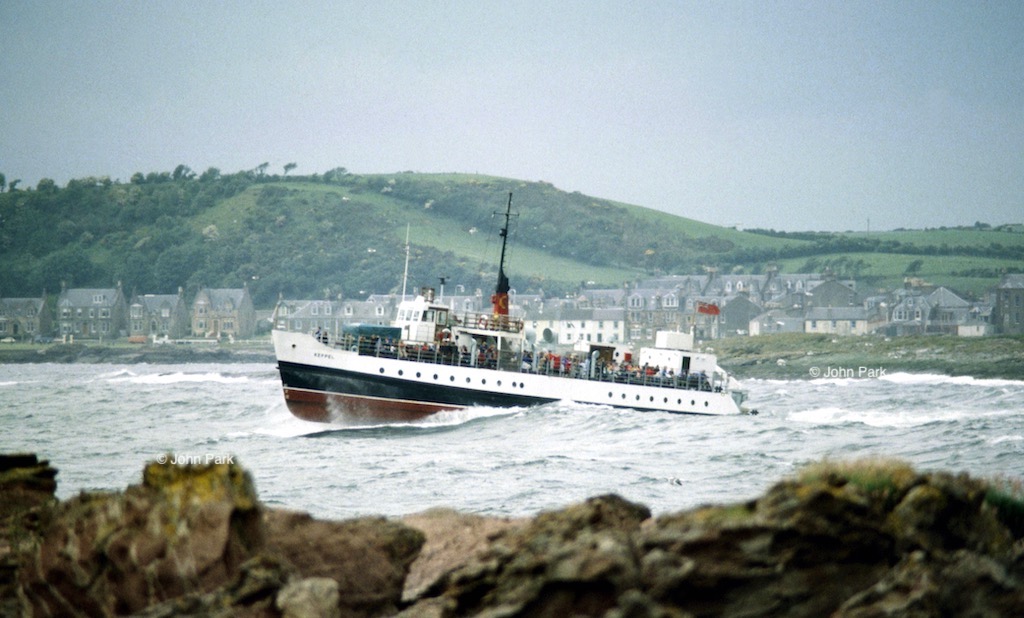
Built in 1961 as Rose for the placid waters of the Thames and transferred to the Clyde in 1967, Keppel had a sturdiness that made her equal to any swell in Millport Bay. Since the mid 1990s she has been a tourist excursion boat at Malta
In a month when ferry disruptions have become almost a daily occurrence, John Park recalls an occasion, more than 40 summers ago, when a small CalMac passenger ferry took on the challenge to beat the waves.
Video clips of ferries battling winter gales make fascinating viewing, and there is plenty of such material on the internet. They remind me of occasions when I’ve watched the slow progress of a ferry ploughing through a large swell somewhere, and perhaps been lucky enough to capture some of the action on film.
The photo above, showing Keppel battling her way out of Millport Bay during a stormy day in 1979, illustrates one such occasion. It recalls a less well known piece of navigation which runs the risk of being forgotten in the mists of time. Older CRSC members will probably be aware of it, but newer and younger members may not have realised it could happen. Now that Millport’s Old Pier is closed to visiting ships, it is unlikely ever to be repeated.

Alistair McMillan and Calum Morrison, best known for their association with the ‘wee ferries’, Countess of Breadalbane and Keppel, served on the Millport run from the late 1950s till their retirement in the late 1970s
A well trained eye might spot that Keppel’s position in the bay seems unusual relative to the background, with the Eileans to her starboard side rather than to port. The reason is that, under certain conditions, Keppel would occasionally sail between the Eileans rather than round them when approaching and leaving the Old Pier. It afforded her some additional shelter, rather than taking the usual course outside of the Eileans and leaving her beam-on to a large southerly swell.
On the day this photo was taken, Keppel had already passed between the Eileans and turned south into the swell, on a parallel course to Marine Parade heading towards Farland Point. An additional benefit of following this course is that it allowed for a quick turn in the swell once clear of the point.
After turning, it is not difficult to imagine Keppel exceeding her somewhat leisurely service speed as she surfed her way down the Largs Channel.
Keppel’s passengers are certainly getting a good heave, which is lifting a remarkable amount of her hull out of the water. What is perhaps even more remarkable is the fact the photograph was taken in June and not during a winter gale!
One of my very earliest Clyde steamer memories is watching one of the two ‘wee ferries’, Ashton or Leven, following this same course in similar conditions. These robust little ferries seemed to sail in just about any conditions, and I have the most vivid memory of watching one of them from our holiday flat in Millport during another summer storm.
She quite literally disappeared from view into the trough between each wave before reappearing some seconds later. Even the bright green canvas round her railings vanished completely out of sight. To an impressionable youngster it was the most vivid and astonishing sight.

Ashton and Duchess of Fife in Millport Bay c1949. The ‘wee ferry’ had just emerged from between the Eileans, while the ‘Fife’ had taken the conventional route out of the bay
The well known black and white photo by Millport photographer Walter Kerr demonstrates one of the pair on the crest of a wave, about to perform this remarkable vanishing trick, while Duchess of Fife in the background is taking an altogether more dignified approach to the conditions.
The larger steamers were unable to take advantage of the sheltered course between the Eileans and had to run across the southerly swell in order to reach the Old Pier. Some of the ‘Maids’ would occasionally be seen setting a course out towards Wee Cumbrae instead of turning as they rounded Farland Point, using the shelter there to come round and take a steadier approach into the Old Pier.
In winter, if the tide was high, experienced masters sometimes followed the unusual course of bringing the main Millport steamer through the channel between the Inner Eilean and the Newton Sands. The paddle steamers Caledonia and Jupiter were captured by Walter Kerr performing just such a manoeuvre.
Those were the days when the Old Pier was a regular port of call for larger steamers. Back then, if the weather suddenly changed and a day on the beach or a cycle round the island wasn’t an option, young steamer enthusiasts had other forms of entertainment with which to occupy themselves!

Caledonia approaching the Old Pier through the passage between the Inner Eilean and the Newton Sands. This is one of many Cumbrae steamer scenes of the 1950s and 1960s captured by Millport photographer Walter Kerr
Further Reading: The success story of Keppel in Malta
Have you joined CRSC? You can do so here for £10 and get all the benefits!
Published on 22 February 2020











